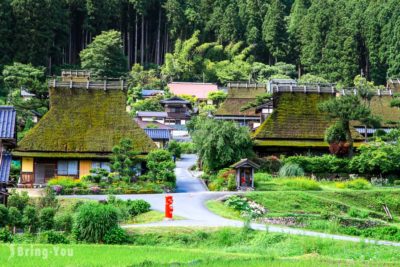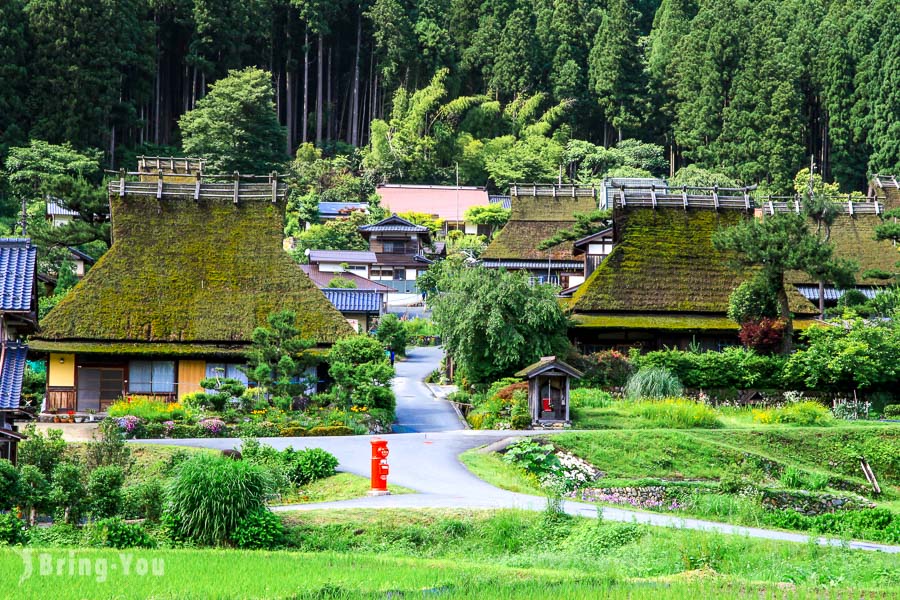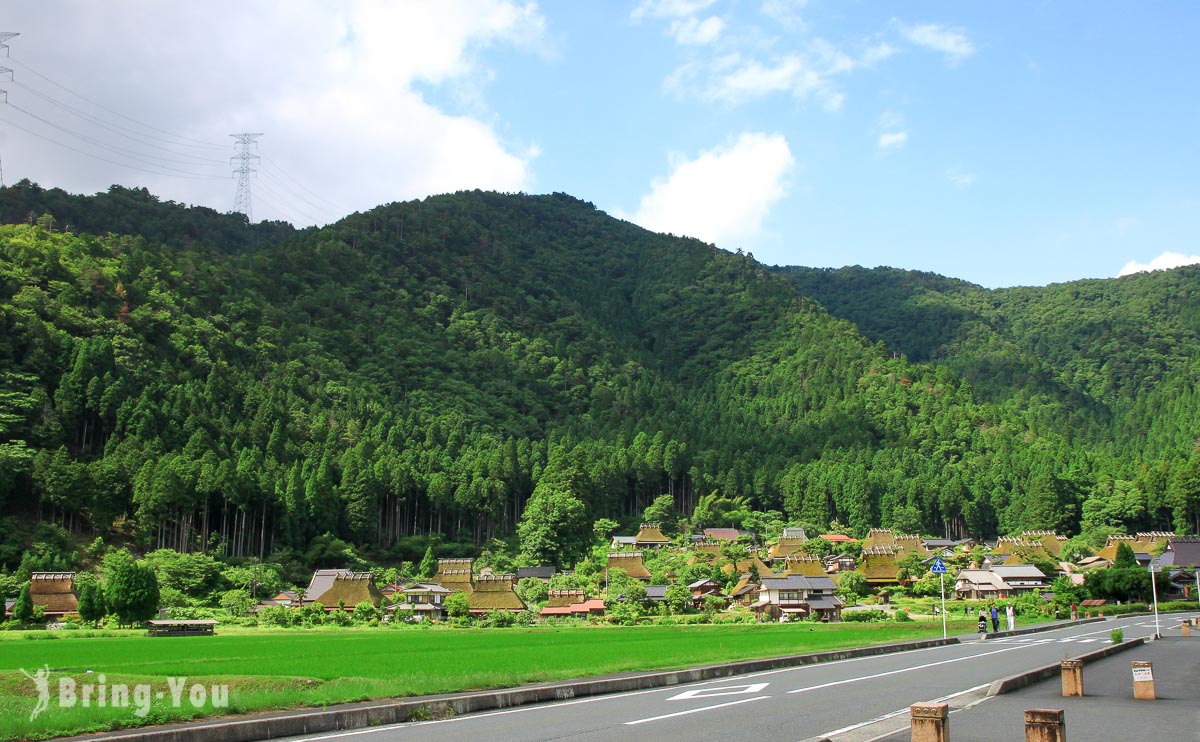
There are three major thatched-roof villages (かやぶきの里) in Japan, with the largest being “Gassho-zukuri Village” in Shirakawa, Gifu Prefecture, which is a World Heritage Site with nearly 100 houses and the largest scale and most commercialization. The second largest is “Ouchi-juku” in Shimogo, Fukushima Prefecture, and the third is “Kayabukino-sato” in Miyama-cho, Kyoto Prefecture, which is the focus of this article. Although it is relatively small and less spectacular, it is the most rustic and authentic spiritual home. Let’s share the transportation methods and good photo spots in Miyama-cho!
【Transportation】How to get to Meiyama Town?
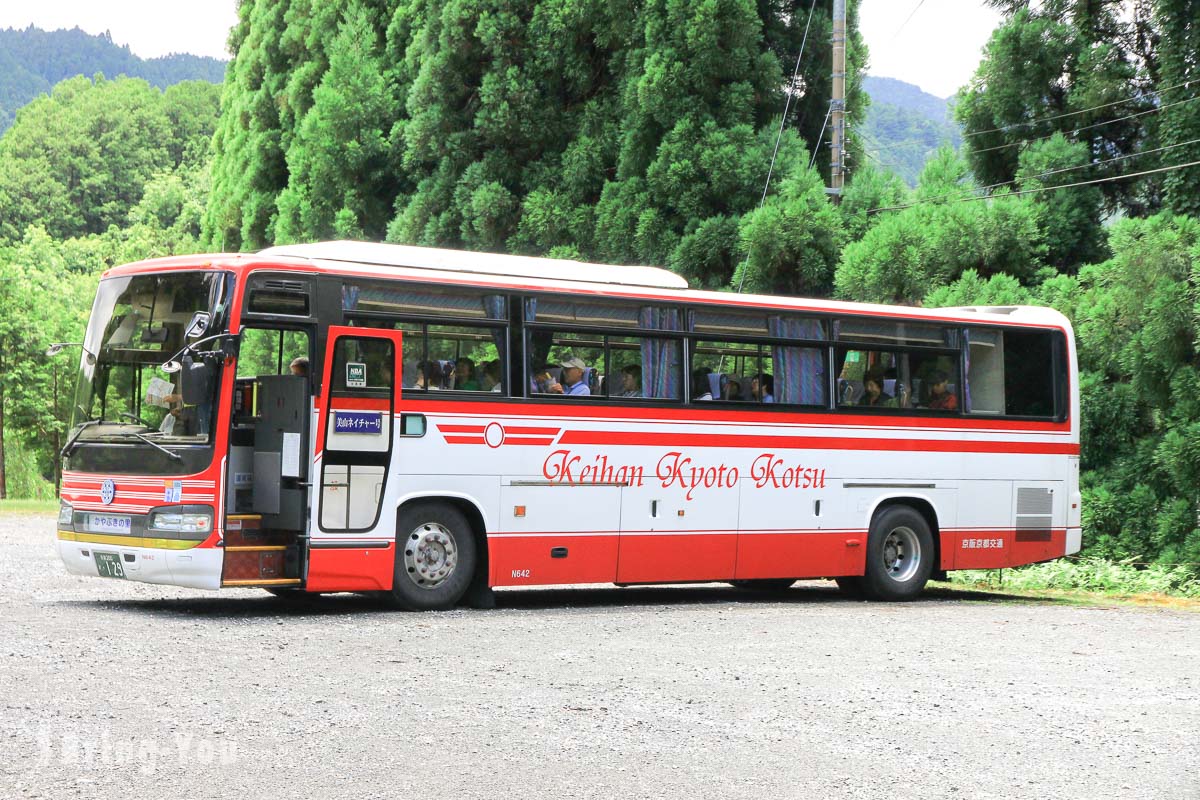
Meiyama-cho (Japanese: Meiyama Kayabuki no Sato) is located in the mountains of Nantan City, Kyoto Prefecture. It is located northwest of Kyoto City and takes about 1.5 hours by car from Kyoto. The transportation is not very convenient, but the following are some easier ways to understand:
【Cheapest】Take JR train and transfer to Nantan City Bus
Take the Sanin Main Line (Sagano Line) from JR Kyoto Station to “Sonobe Station” or “Hieizan-Sakamoto Station”, then transfer to the Nantan City Bus “Chimikko Line” or “Miyama-cho Nature Culture Village Line” and get off at “Kita Station (Kayabuki no Sato)”. The journey takes about 2 hours by train and bus, costing around 1,480 yen. This is the cheapest transportation option, but there are not many trains, so plan your trip carefully. You can also use the JR Kansai Wide Area Pass for the entire route.
Some JR trains departing from Kyoto to Hiyoshi Station will separate the front and rear cars at Sonobe Station, heading to different destinations. There will be announcements on board or you can check if the destination is “Fukuchiyama” written outside the car. It is recommended to sit in the first two cars to avoid any confusion.
【Most Convenient】”Kyoto Miyama Line” Operated by Keihan Kyoto Kotsu Bus
If you don’t want to worry about transportation for transfers and want to fully enjoy all the scenic spots in the mountainous area in a day trip, the best way to travel is the Kyoto Miyama Line operated by Keihan Kyoto Bus. The bus will directly depart from Osaka or Kyoto to Miyama, and the Miyama scenic spots and souvenir shops that have been planned along the route will have ample time to stay, which is also the method I chose. However, because it is limited time and requires advance reservation (guaranteed seats), the tour guide on the bus speaks Japanese! But they will provide Chinese maps and route maps. The following are the introductions of the three routes, and reservations can be made on the Keihan Kyoto Bus official website, which can be made one day to two months before the departure date.
Because Piao Er lives in Osaka, she chose to take the second “Necya Bus” to complete the one-day tour of Mount Mei.
Detailed Bus Routes and Attractions: Mei Shan Transportation: Introduction to Scenic Spots Along the Mei Shan Nature Tourist Bus Route
【Most Expensive but Fulfilling】Join the Meiyama Town One-Day Tour
If you come to Misaka just to see the thatched-roof houses in Shirakawa-go and don’t plan on visiting any other attractions, or if you think that you’ve already traveled so far from Kyoto, you might as well explore the outskirts of Kyoto. You can read about the hidden gems of Kyoto, or check out the travel guides for Amanohashidate and Ine no Funaya. If you’re interested, you can also join a one-day tour with a Chinese-speaking guide to visit Amanohashidate, Ine no Funaya, and Miyama-cho. Although it’s the most expensive option and the time spent at each attraction is limited, you don’t have to worry about how to arrange transportation to these three difficult-to-reach attractions, which is very convenient.
- Most Popular Itinerary: Amanohashidate, Ine Funaya, Miyama Town Day Tour
- Winter Exclusive: Miyama Yukiakari no Michi Snow Lantern Festival Night Tour
- Charter: Miyama, Amanohashidate, Uji Three Scenic Spots Route of Your Choice
Kayabuki no Sato Kitamura (Village of Thatched Roofs)
On this day, we took the Meiyama Nature Bus for a one-day trip to Meiyama. After visiting the Meiyama Souvenir Shop and the Joushokoji Temple, we arrived at the third stop, the “Meiyama Thatched Roof Village (Meiyama Kayabuki no Sato),” which is also the location of the Meiyama Thatched Roof House Settlement. We arrived at the birthplace of the thatched roof, a spiritual home for the Japanese people. The charming thatched roof houses are located on a plain in the middle of the primitive forest, giving a feeling of being in a traditional Japanese society like in the anime “Non Non Biyori.”
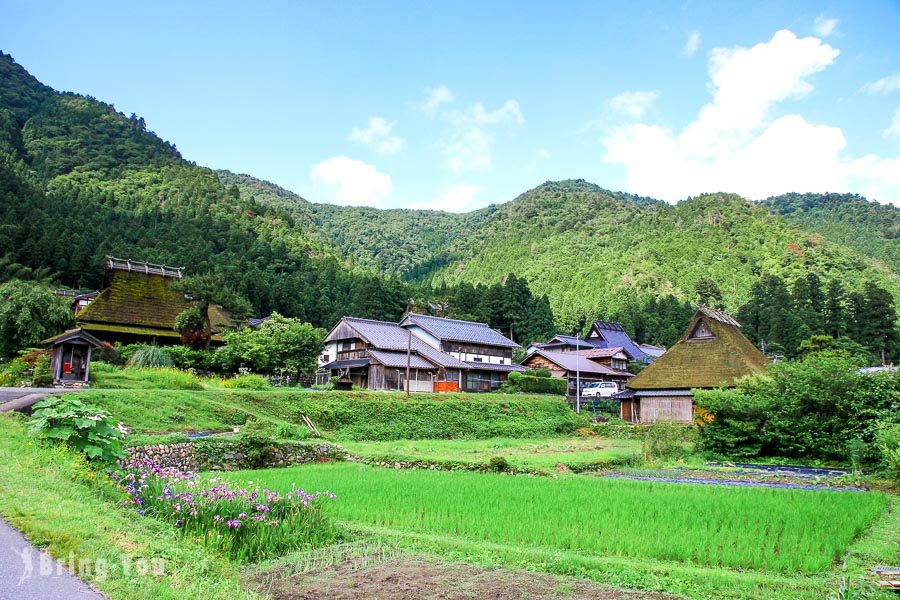
Due to the weather, we chose to take shelter from the rain and have lunch at the “Natural Culture Village Helu Manor” at the fourth stop of the Meishan Nature Bus. Then we walked back to the third stop, the “Meishan Thatched Cottage Village”. Therefore, we took the completely opposite route from the most beautiful scenery that a regular tour bus would take, starting from the left parking lot. We started from the Hachiman Shrine on the right and enjoyed the scenery along the way. The most impressive view of Meishan was when we left, with the thatched cottages shining in the sunset glow.
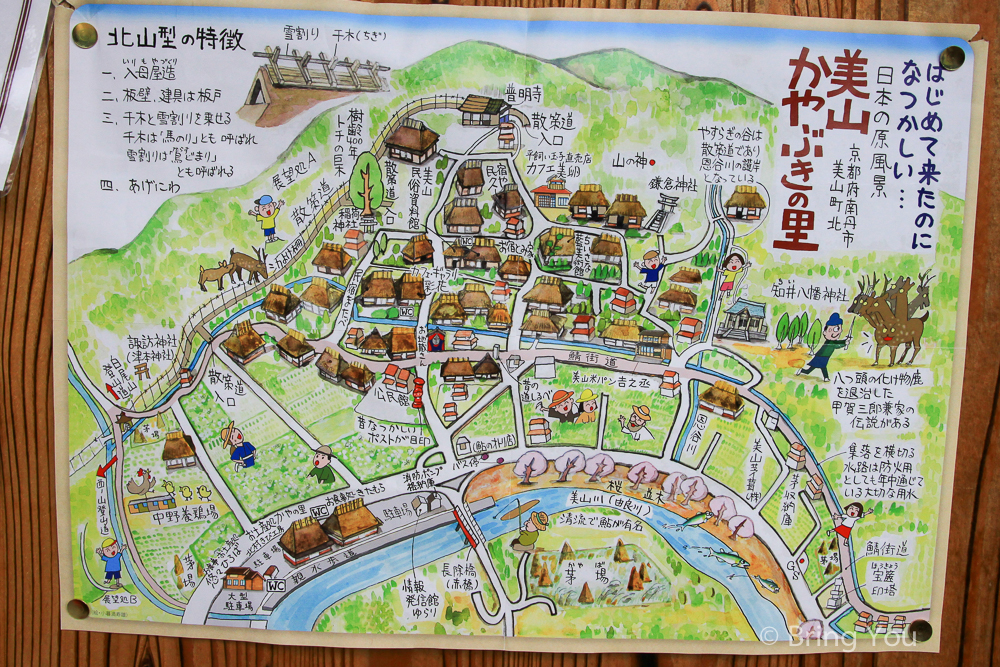
The well-known thatched village is the “North” settlement in the Meiyama Chikai area. Independent travelers can get off at the “North Station” by bus, which is the village “North”. There are a total of 50 households here, of which only 38 are thatched houses, while others are wooden houses like the one below, some of which are used as residences, and some are used as shops or information centers.
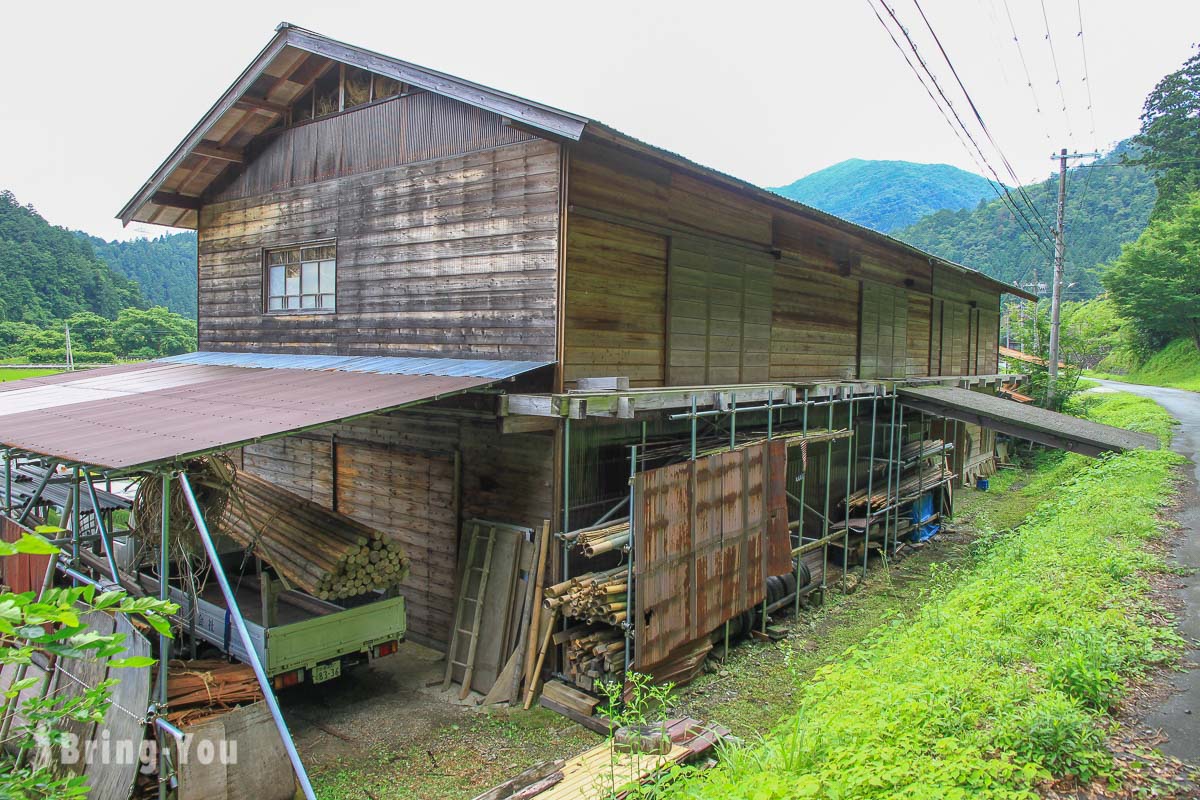
Chizuka Hachiman Shrine
Other temples and shrines that can be visited in Mishima Town besides Kamakura Shrine at Fumyoji Temple include Yawata Shrine (officially known as Chii Yawata Shrine).
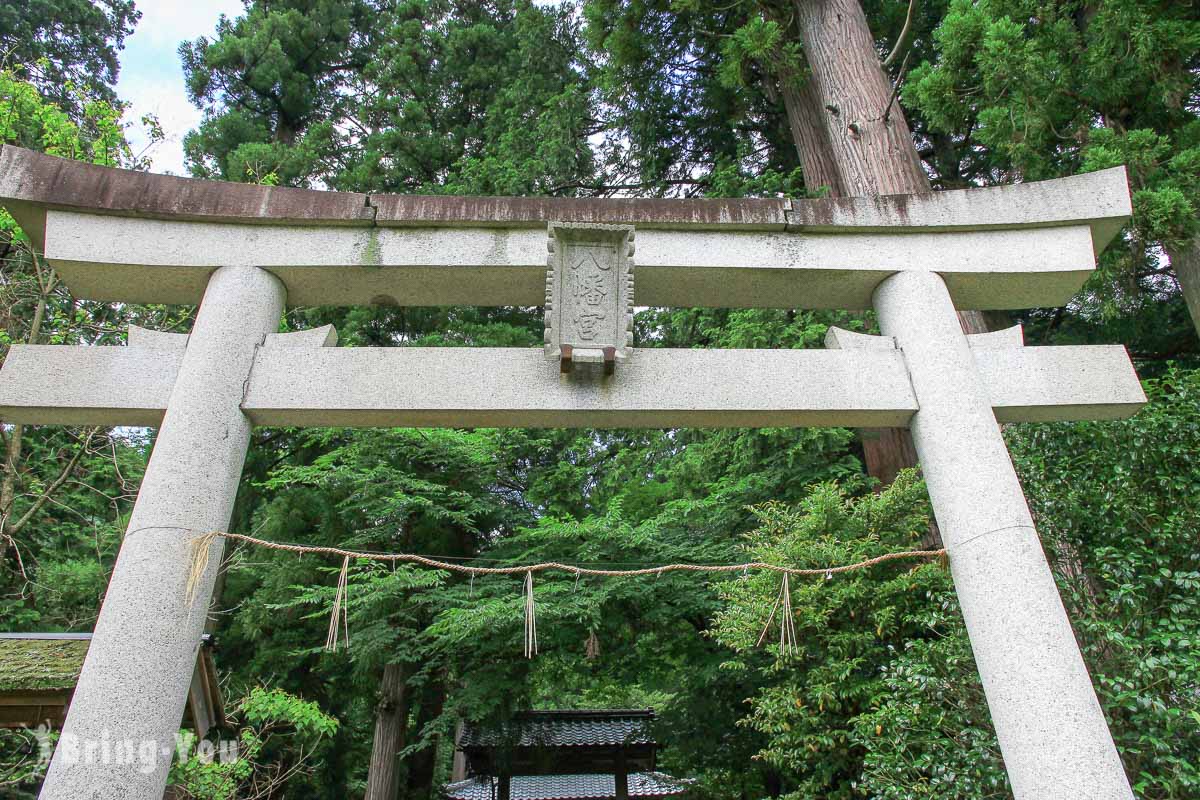
The history of Hachiman Shrine dates back to 713 AD, when a deer with eight heads brought disaster to this area. Later, a court official named Koga Saburo drove away the monster, and in gratitude, this shrine was built.
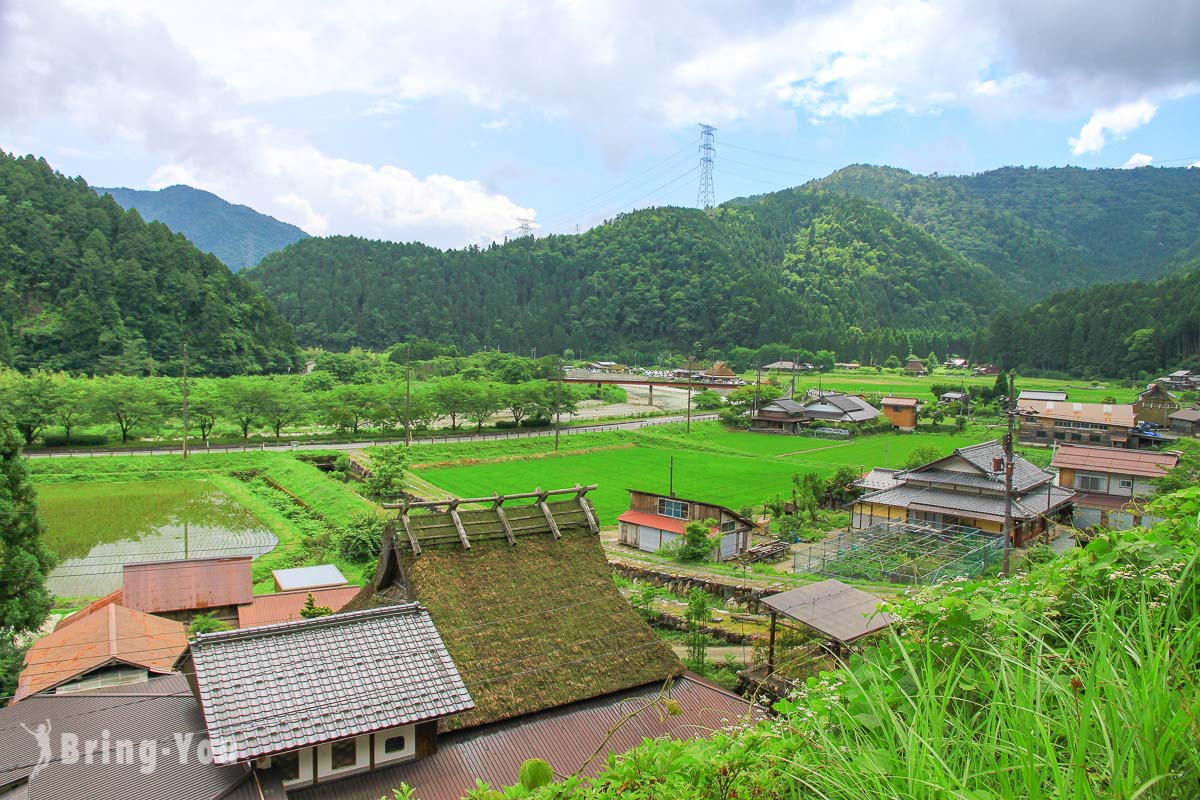
Looking down on Mishima-cho from above the shrine, the scenery of rural fields and thatched-roof houses is intertwined, creating a very leisurely feeling of the countryside.
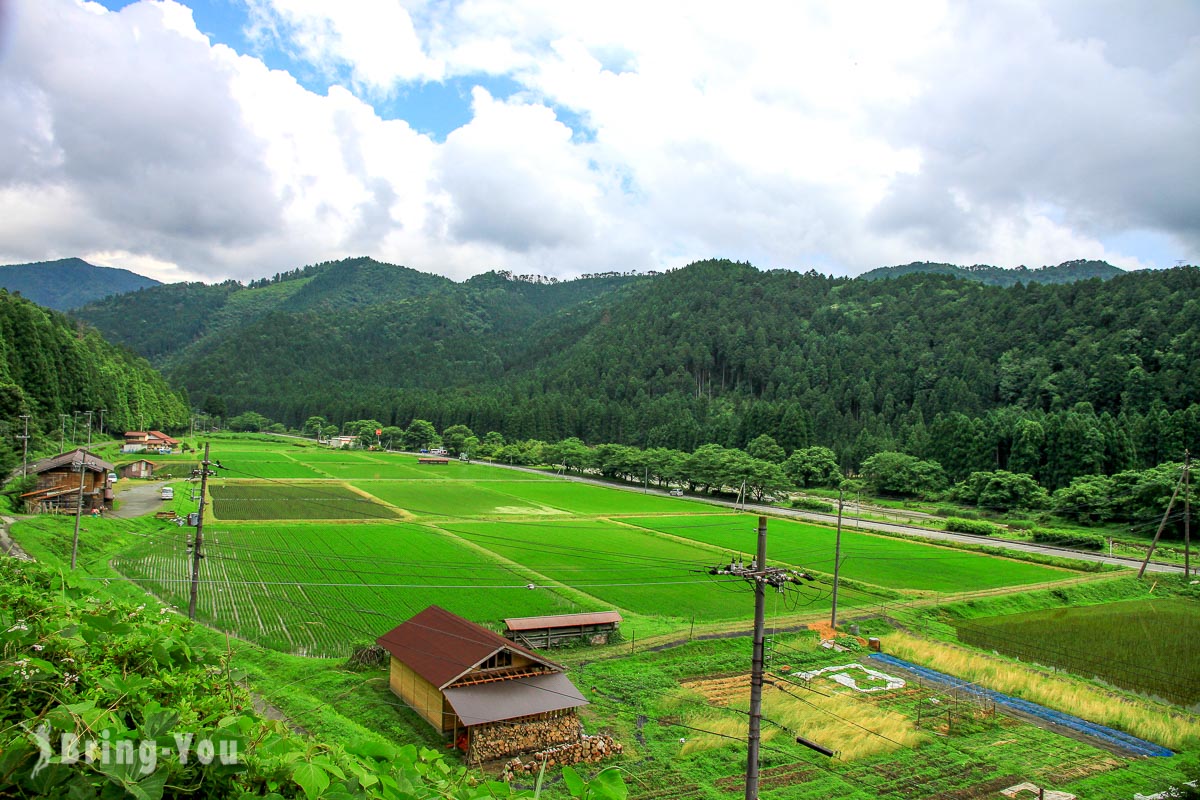
No one was at the Hachiman Shrine, and even the office looked desolate.
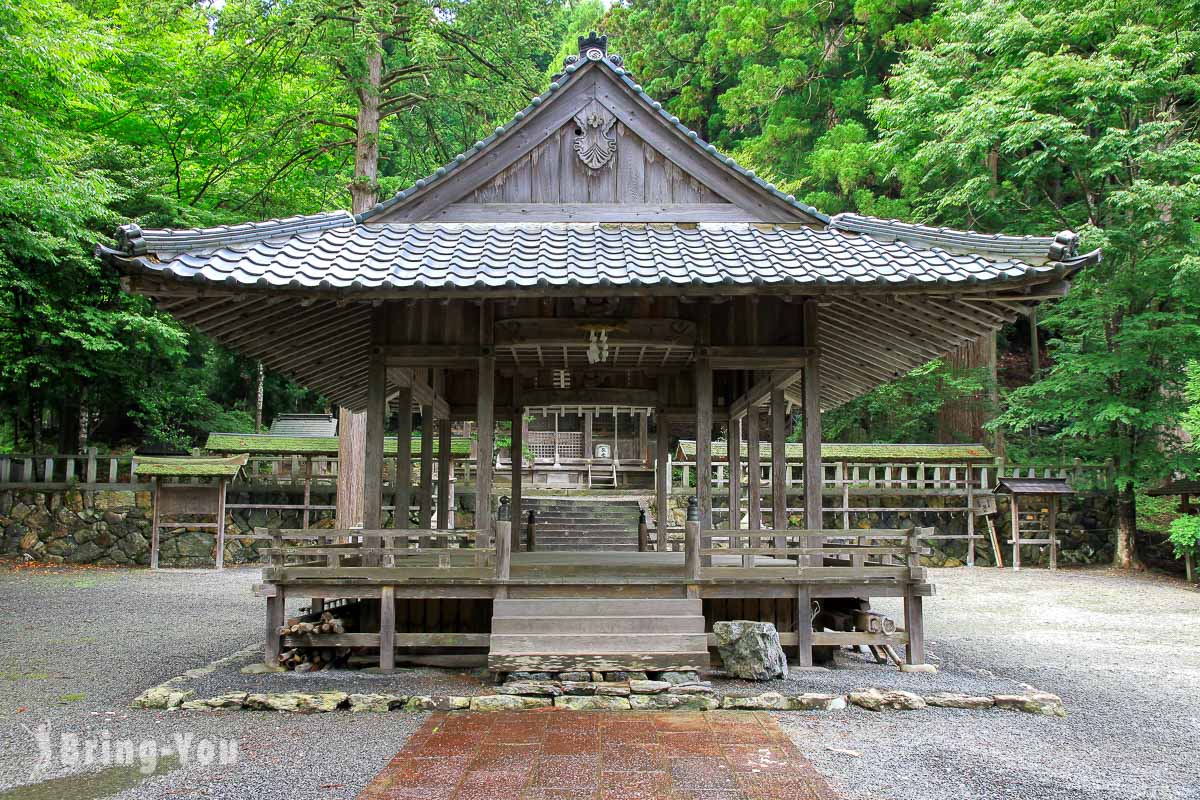
Ji no Jo
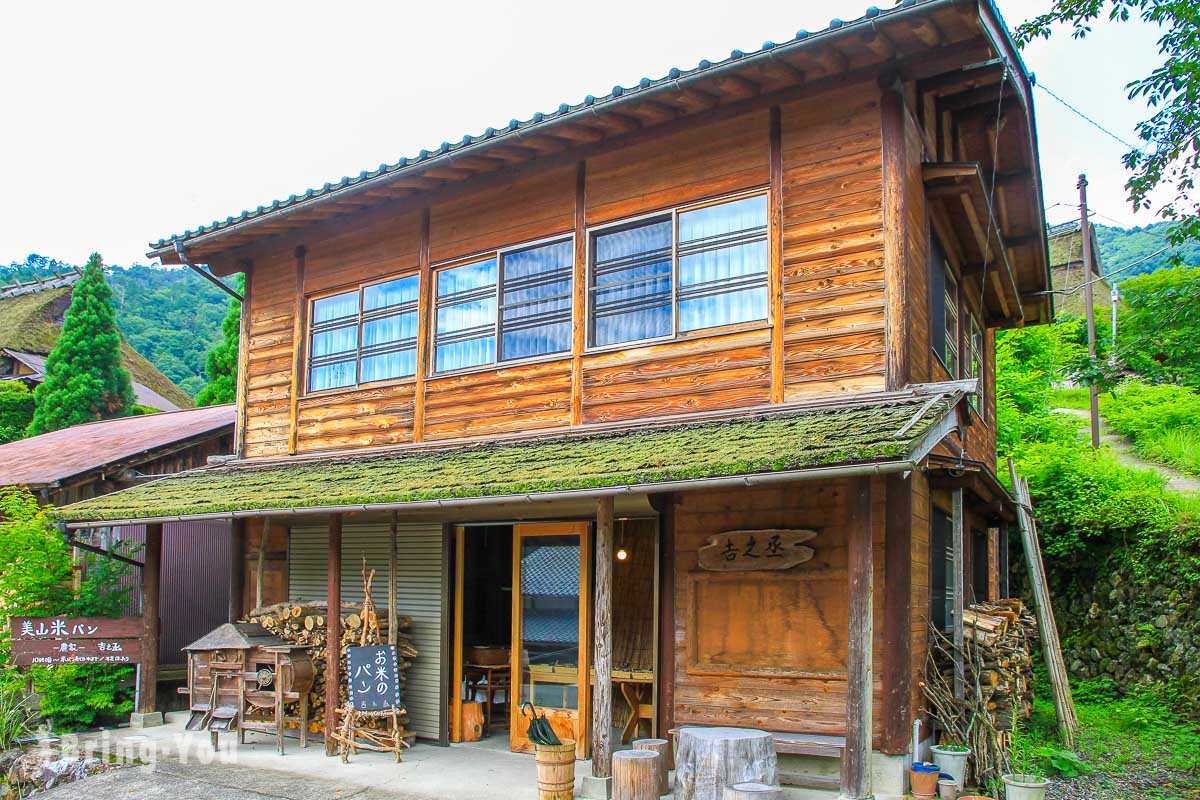
After coming down from the Hachiman Shrine, there is a wooden bakery next to it that specializes in selling rice-made bread made from Miyama rice.
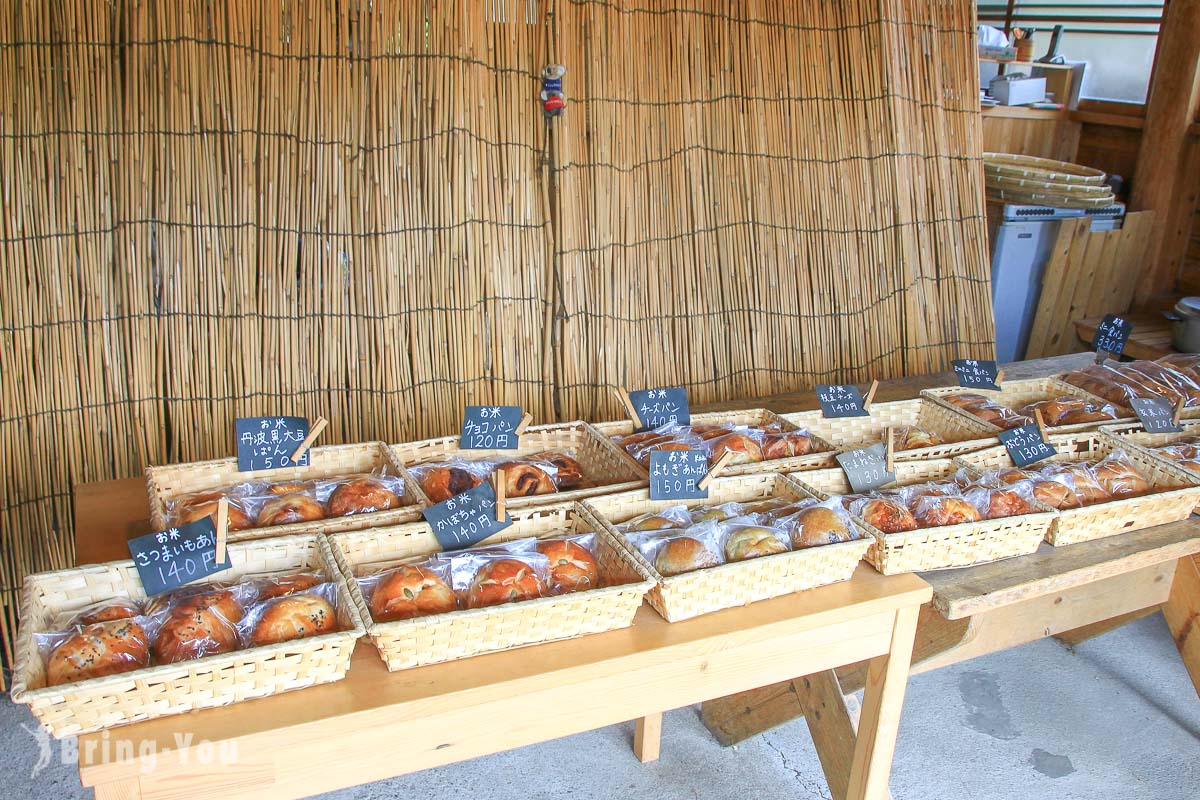
There are many small details in Meiyama that showcase its local characteristics, such as the pattern on the drain covers, which features the local specialty – ayu fish. You can also find unmanned vegetable stands, a common sight in rural Japan, which adds to the unique charm of Meiyama town.
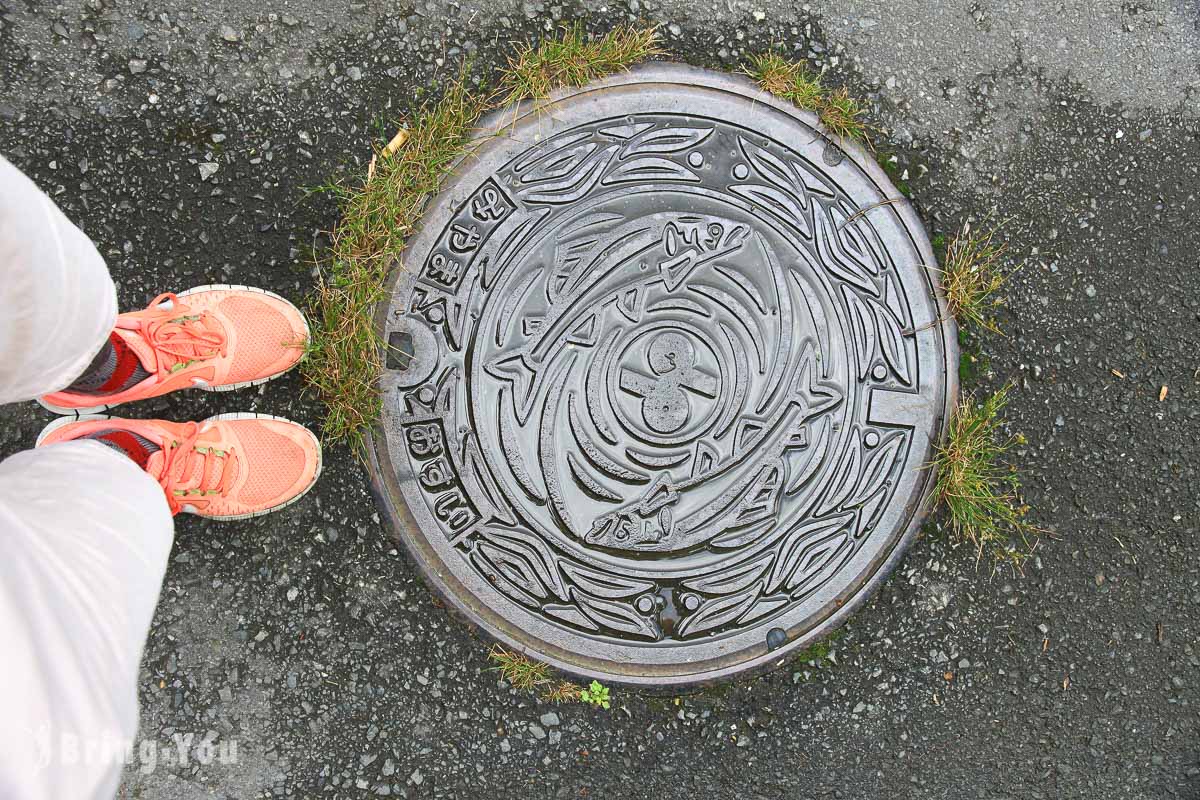
Meiyama Thatched Cottage Village (みやまかやぶきの里)
Continuing down the mountain, you will reach the Meishan Thatched Cottage on the flat ground. These thatched cottages have a history of 150 to 200 years! As they are completely fixed by tenons and ropes without a single nail, they will naturally deteriorate over time. Therefore, the thatched roof needs to be renovated every 20 years. Thanks to the efforts of the villagers, the government now provides a three-quarters subsidy to assist in the renovation of the thatched roof.
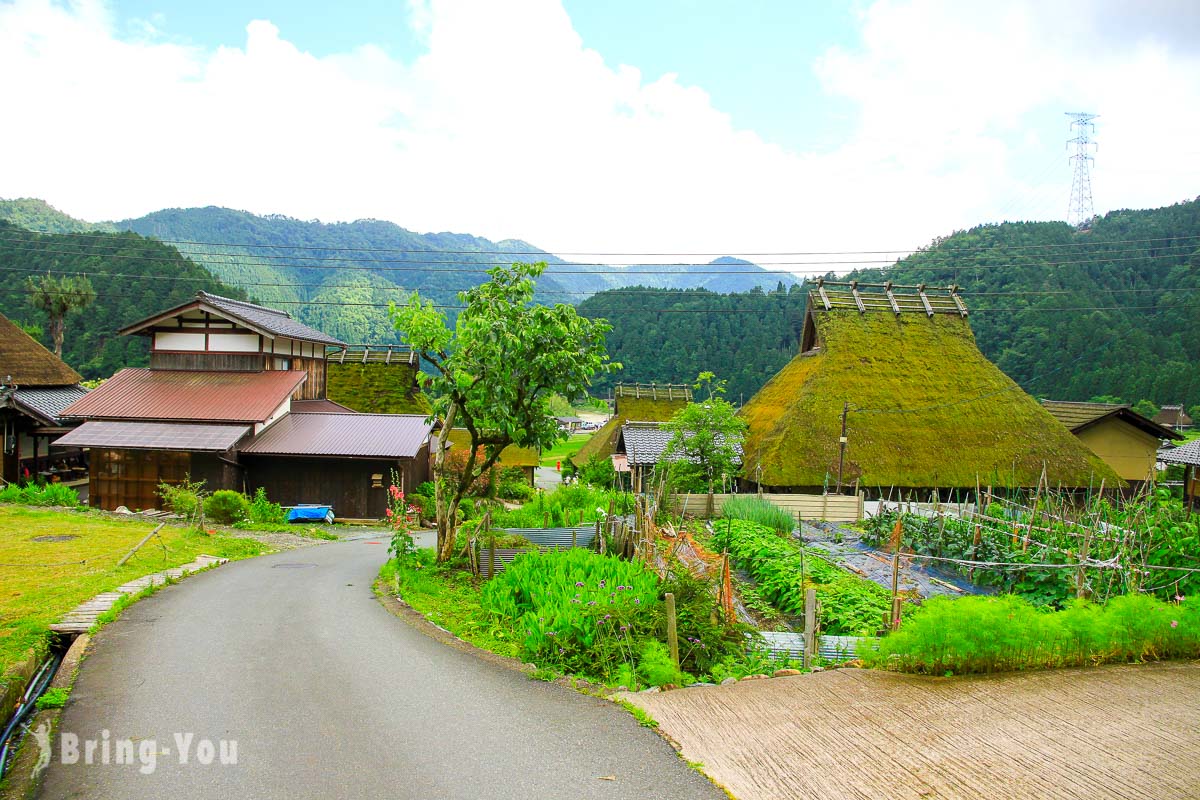
Walking from the parking lot towards the thatched cottage, you will see this fiery red and passionate mailbox. If you want to send a postcard, don’t miss the beautiful stamp of Meishan!
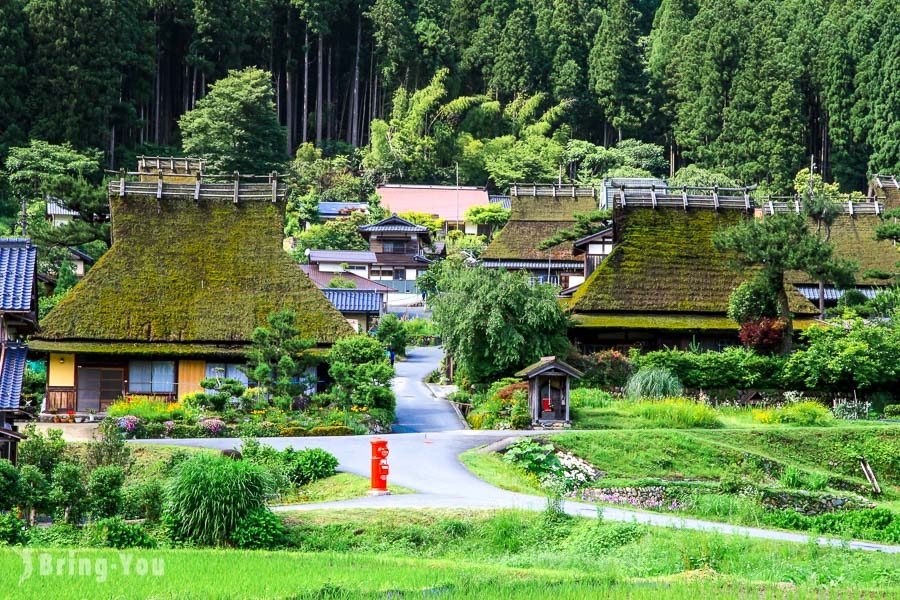
The thatched houses in Mishima-cho have a feeling of being in a village from the Edo period. If you observe the architecture closely, you will notice that it is different from the gassho-zukuri architecture of Shirakawa-go. The thatched houses in Mishima-cho belong to the Kitayama-style houses, with the upper part of the architecture being a gable roof and the lower part being a hip-and-gable roof.
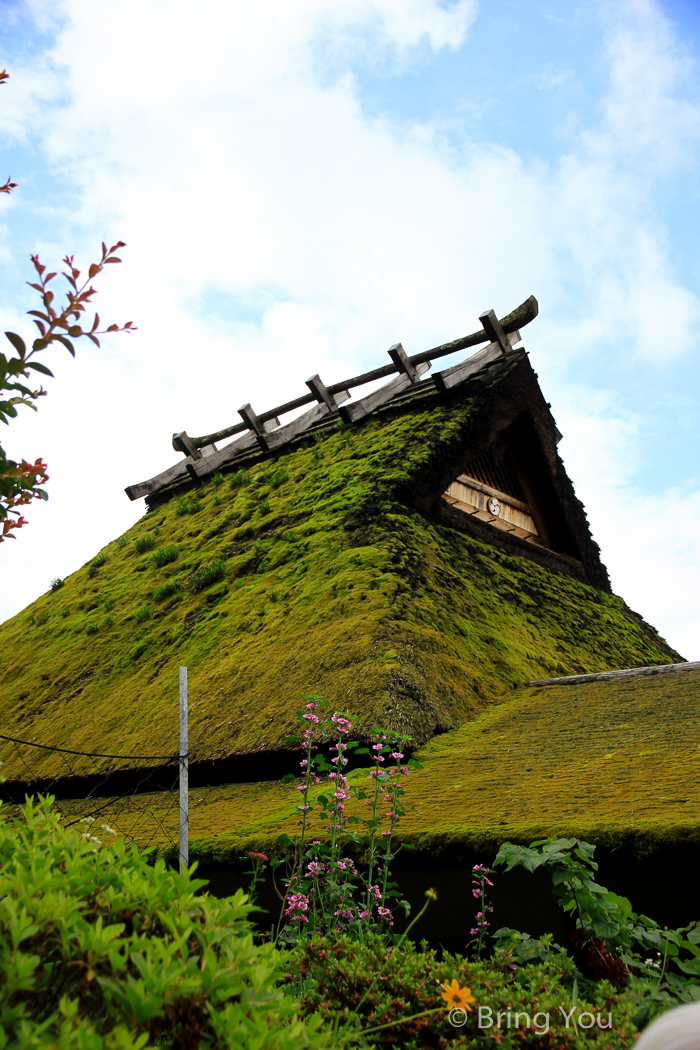
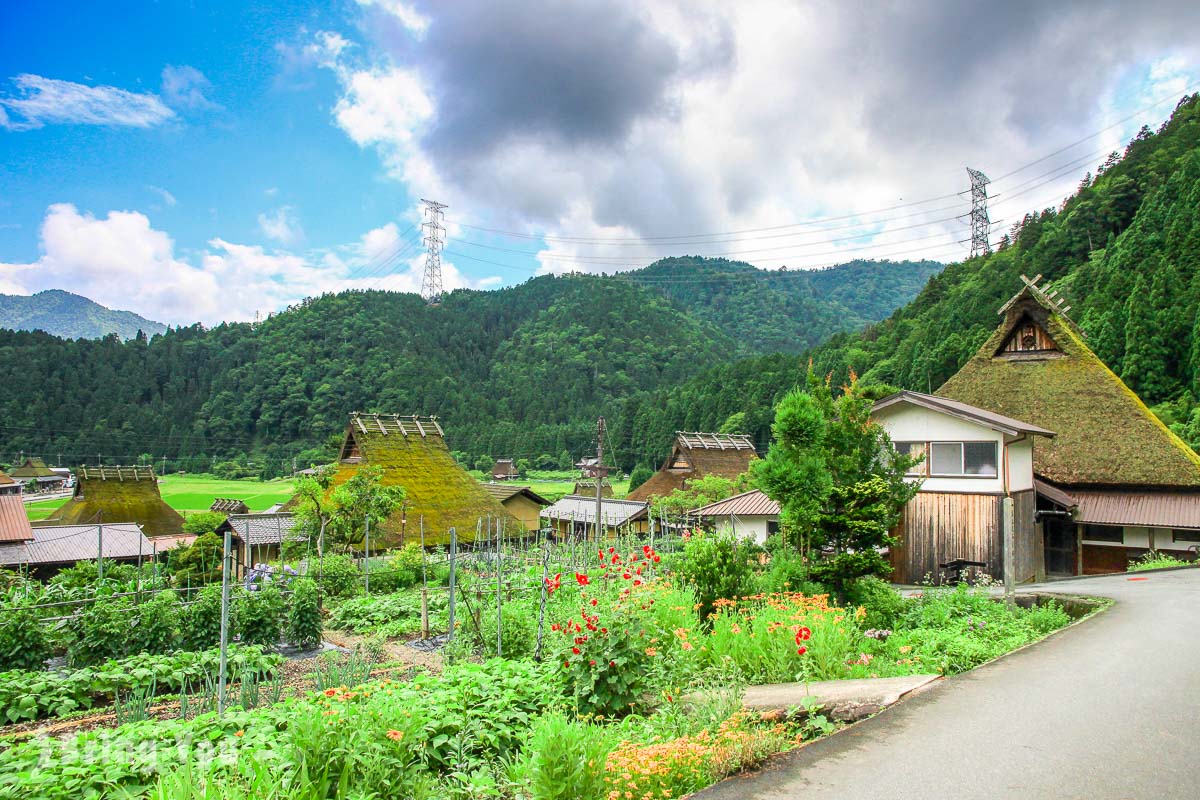
During the rainy season in June and July every year, it is the time when hydrangeas (あじさい) bloom. In Mishima, residents of Chigusayama carefully arrange the beautiful flowers and enjoy them while sitting under the thatched roof, creating a unique atmosphere.
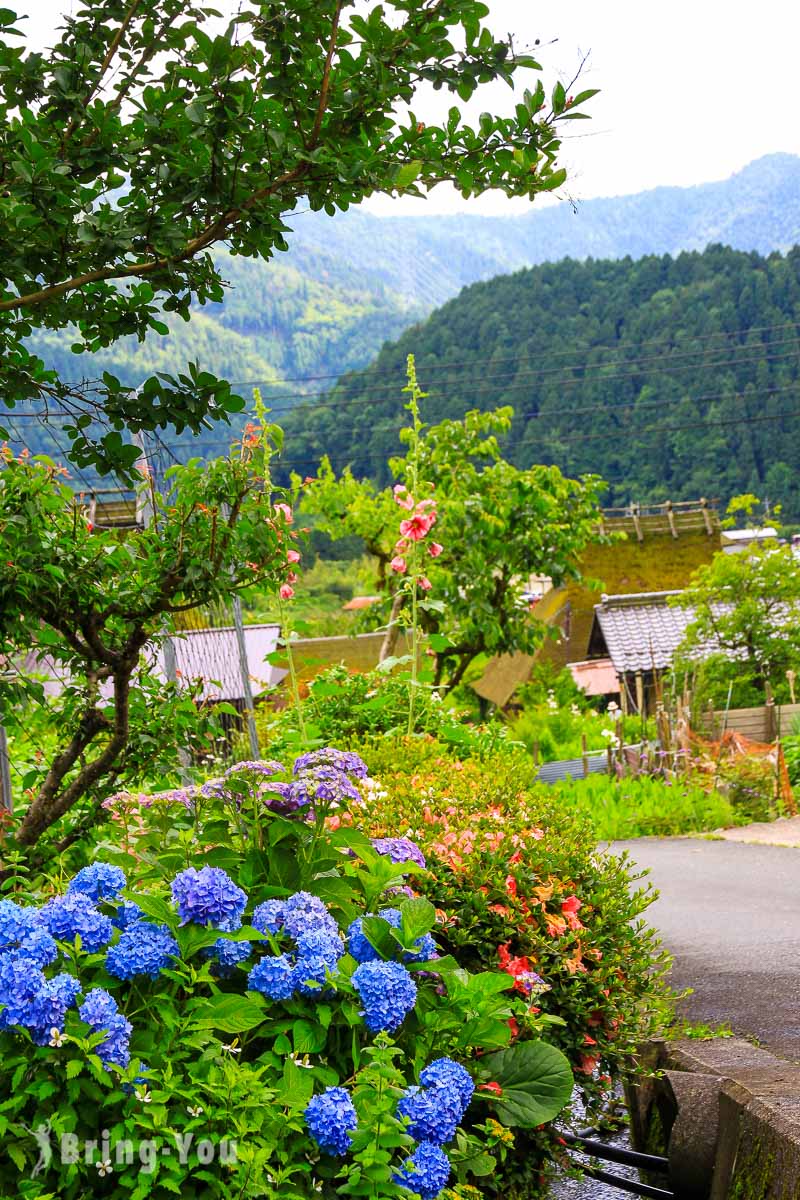
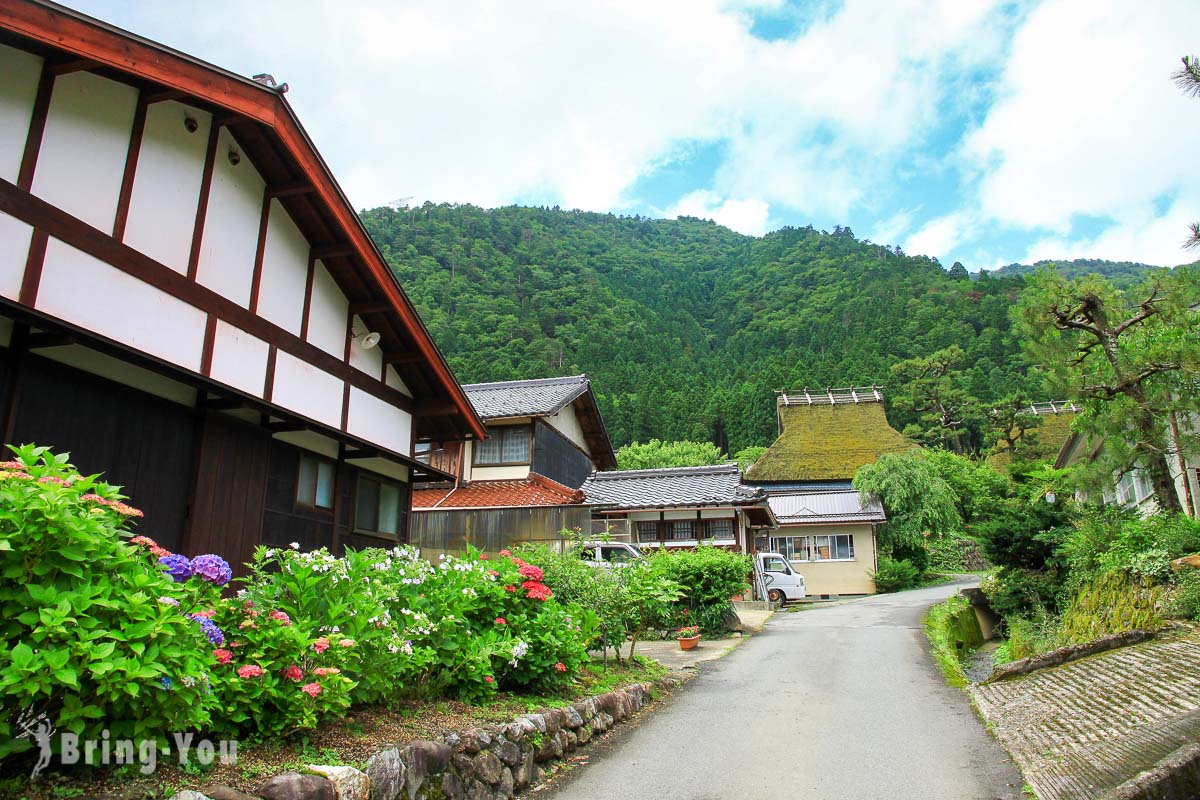
The thatched roof of this house is designed to avoid the heavy pressure of snow in winter. The steep slope makes it easier for the snow to slide off and reduce the burden.
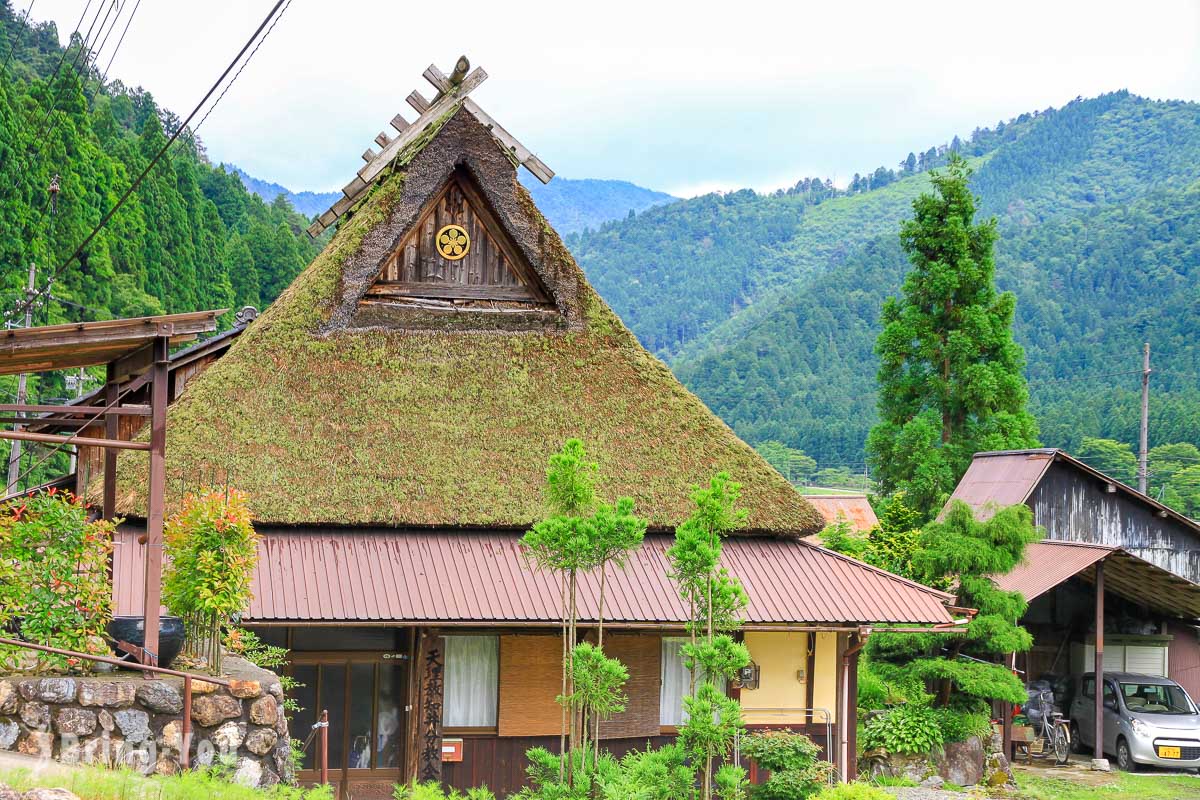
Using local materials such as reeds and straw to weave the roof, tightly binding and layering bundles of reeds, and finally trimming them neatly. Nowadays, only experienced and skilled master craftsmen with strong physical strength are capable of this craft.
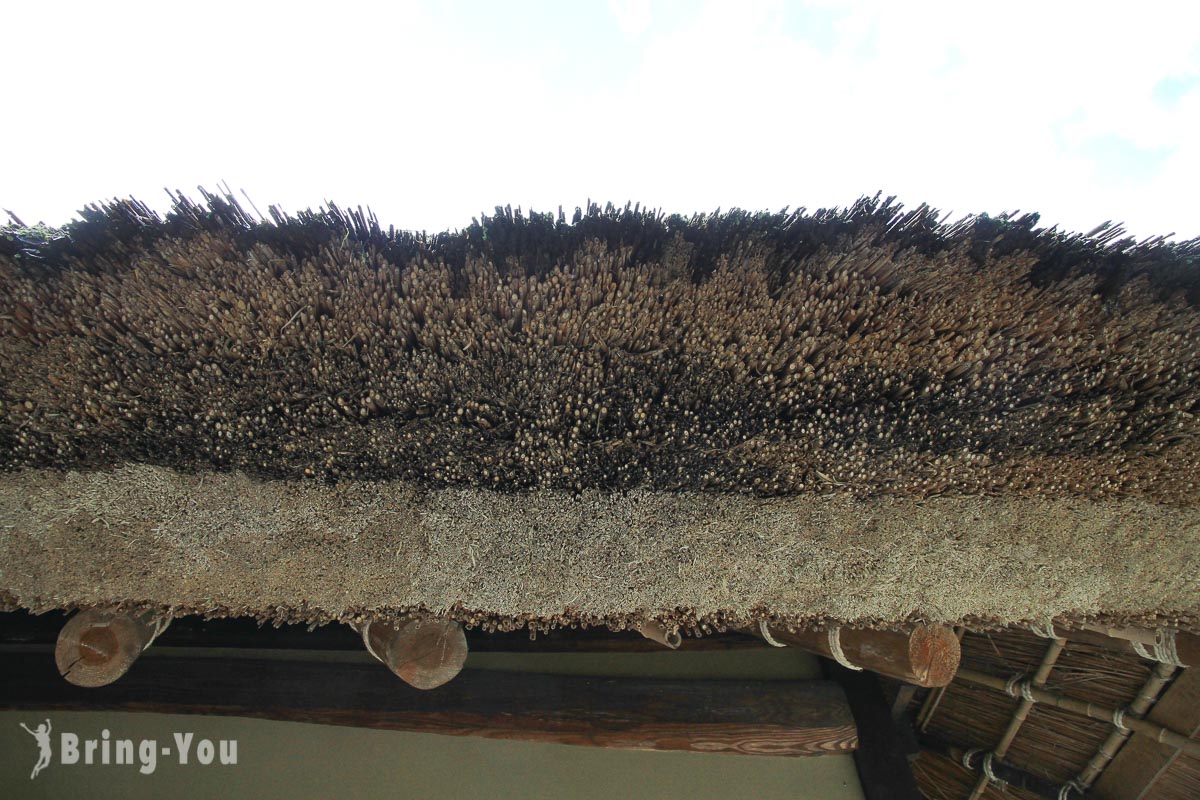
Japanese Dragon Boat Festival and Children’s Day Carp Flags
Actually, I was puzzled when I saw the carp flags in Meisan. I thought it wasn’t Children’s Day, so why were there carp flags? After some research, I found out that May 5th is Children’s Day in Japan, which is the same day as the Chinese lunar calendar’s Dragon Boat Festival that Taiwan was celebrating when I was in Japan!
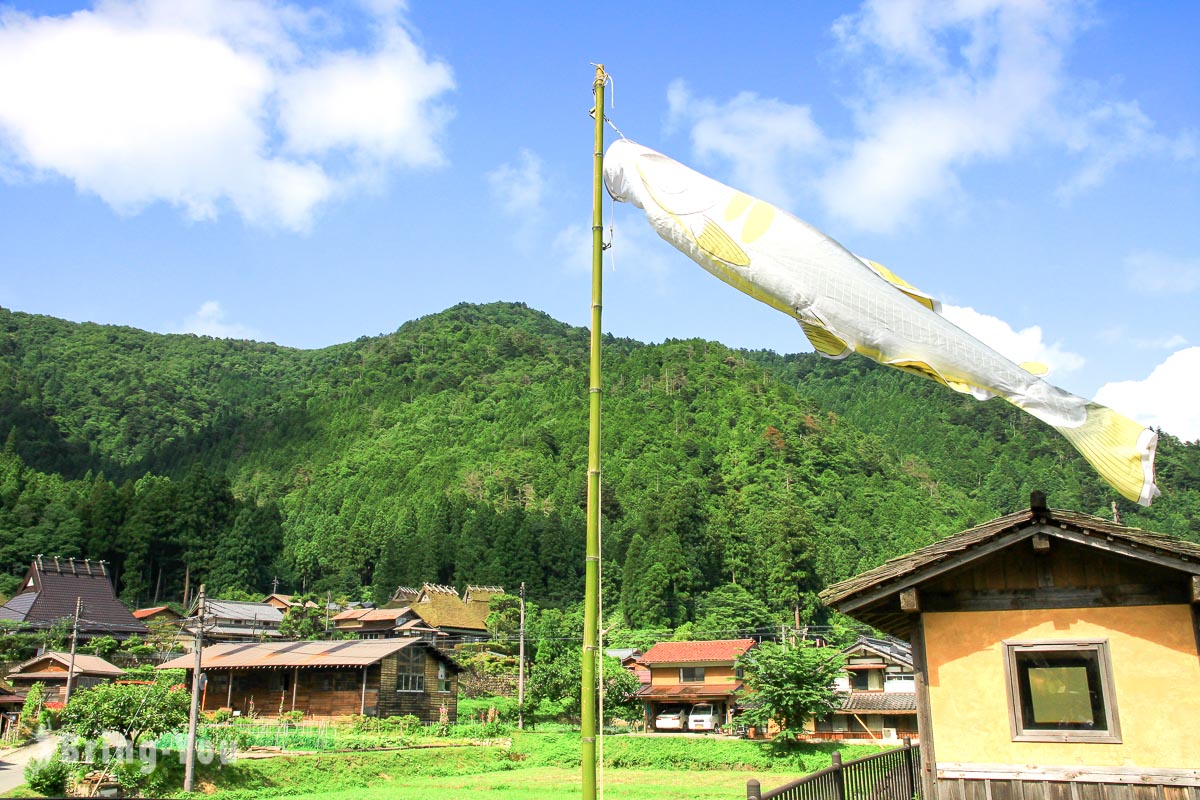
Japanese people believe that koi fish are the most spirited and energetic, and they hope that boys will be like koi fish, symbolizing the leap of the dragon gate. Koi fish flags are hung on golden windmills. However, the common colors of koi fish flags are black, red, blue, green, and pink. Each color has its own meaning: black represents the father; red represents the mother; blue and green represent boys, while pink koi fish flags are for little girls. But this one seems to be golden? I wonder what the meaning of the golden color is???
Colorful Flower Coffee Art Gallery
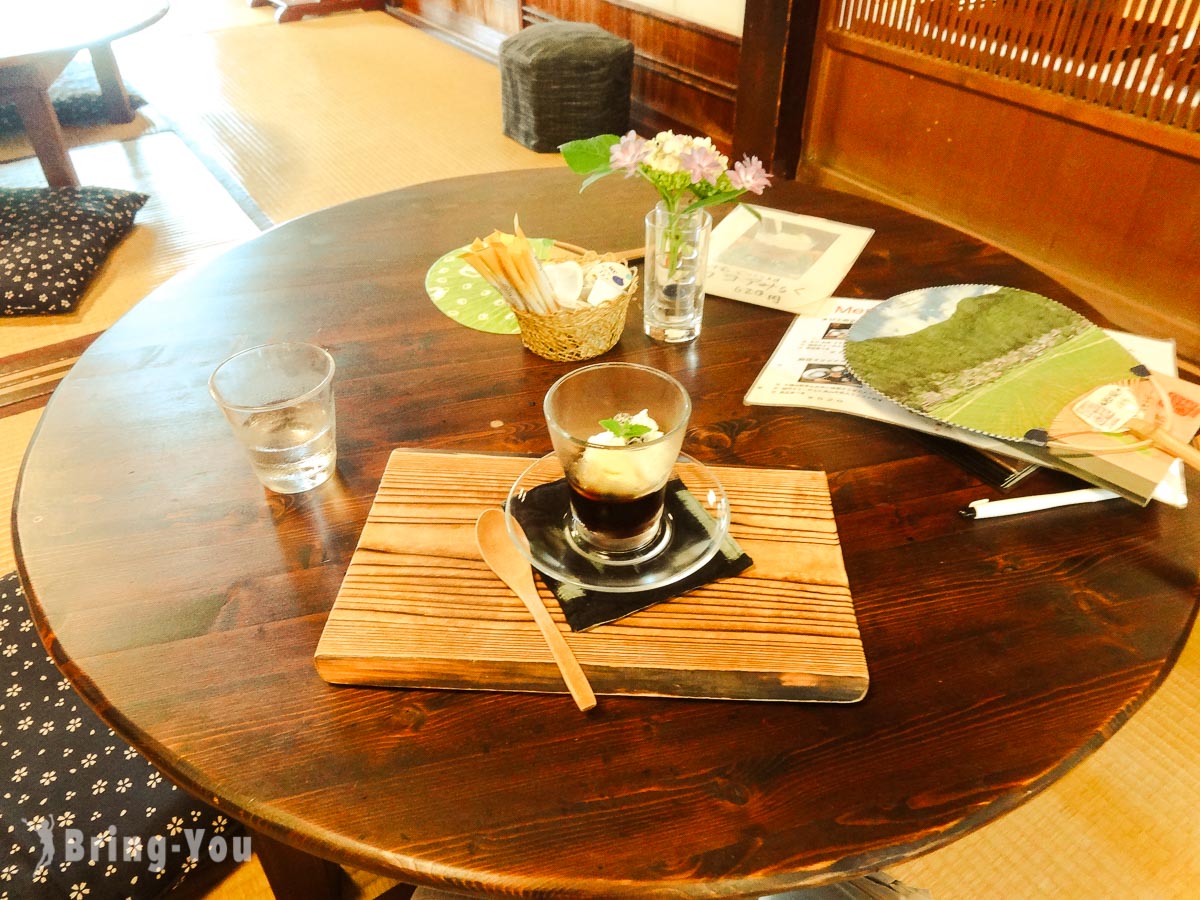
Most of the houses in Kitamura, Mishima Town are residential, with only 6 thatched-roof houses serving as folk museums and restaurants. Due to the limited return time of the bus, I chose to dine at the “Saihwa Coffee Art Gallery” café, where I could briefly stop. The owner speaks English very well, and communication is smooth. The interior is a Japanese-style low table with tatami mats. Here, I ordered a cup of Mishima’s specialty black bean coffee jelly and ice cream, which was very leisurely and happy.
Dining environment and dishes: Miyama Cafe’s delicious black bean coffee jelly
Full View of Thatched Cottage
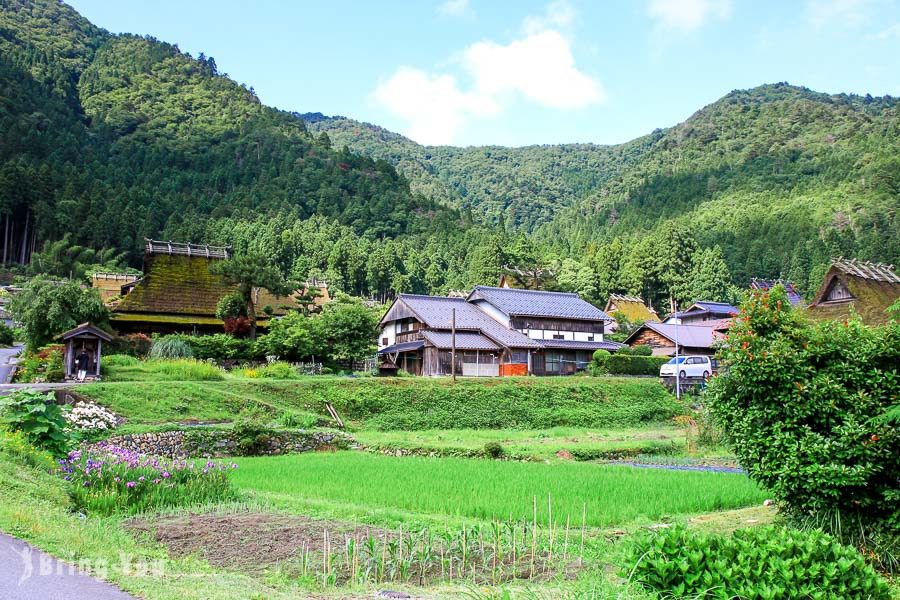
The best angle to take photos of Meiyama Town is from the panoramic view when walking towards the village from the parking lot (whether by car or bus). Don’t forget to turn around and take another photo before leaving.
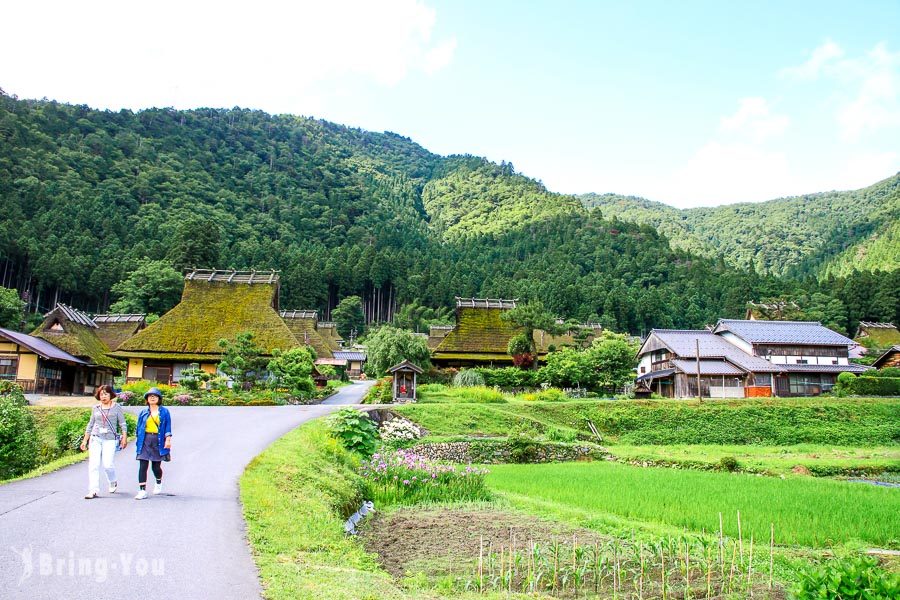
Every year on May 23rd and November 23rd at 11:15 am, which is also the peak season for tourists, is to witness the spectacular scene of dozens of huge water columns spraying onto the roof during the fire drill in Meishan. Photography enthusiasts who are interested can also come specially at this moment!
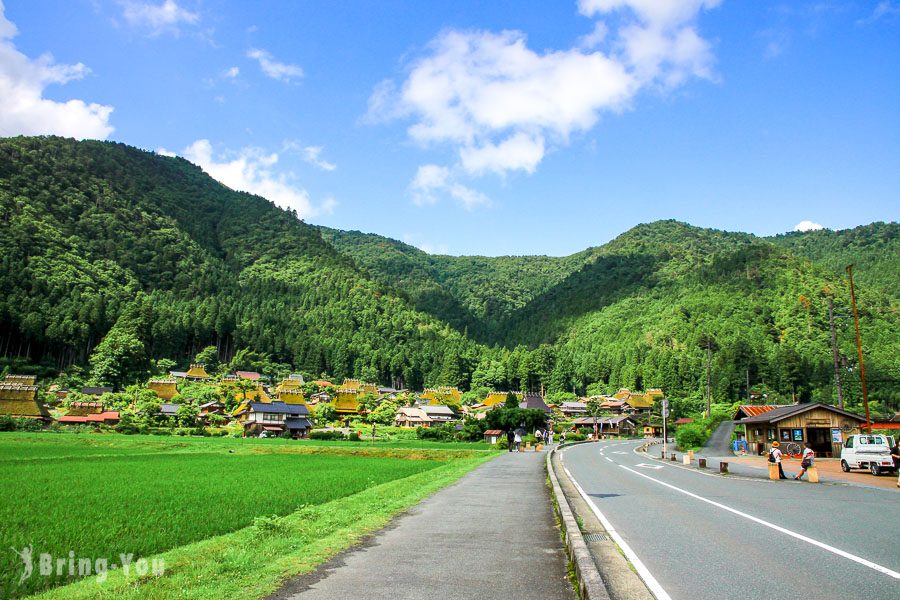
Slow down your pace, breathe in the fresh air, and experience the century-old thatched village, embraced by mountains and the simple countryside. Stroll along the rural roads and feel the unique tranquility of Meiyama, the “spiritual homeland of the Japanese.” In just over an hour, you can roughly grasp the appearance of this place, but only catch a glimpse of the panoramic view of Meiyama’s life. If you can stay for one more night, I believe the feeling of bathing in the forest in the morning will be particularly different! Meiyama is beautiful. If you like the quiet and pastoral scenery, you may also find a small piece of tranquility in your heart here.
One-day Tour Itinerary in Meishan
【One-day Tour Itinerary of Meiyama Nature】08:40 Jinghan Katsuracho Station → 10:14 Meiyama Souvenir Shop → 10:44 Joshokoji Temple → 12:25 Village of Thatched-roof Houses → Natural Culture Village (optional) → 15:13 Oishi Sake Brewery → 15:43 Michi no Eki Station → 17:34 Jinghan Katsuracho Station
Here is my one-day bus tour itinerary. You can click on the links to see the introductions you are interested in, or click here to see the detailed route of the Meishan Nature Tour.
One-day tour to Miyama with Chinese-speaking guide for a more relaxed experience: Amanohashidate, Ine Funaya, and Miyama Kayabuki no Sato
